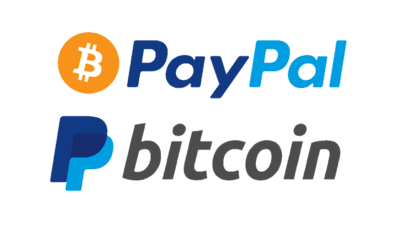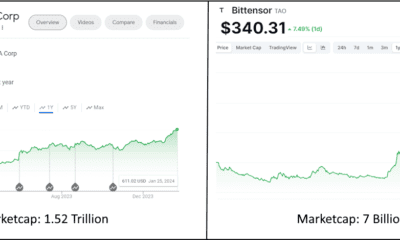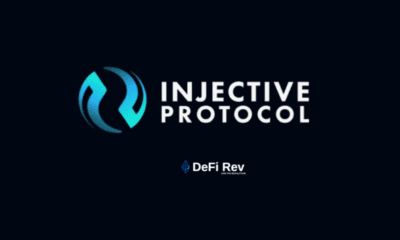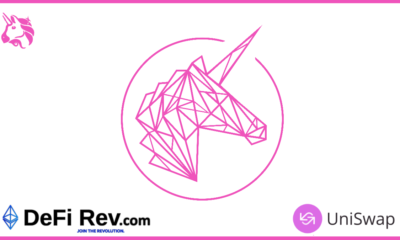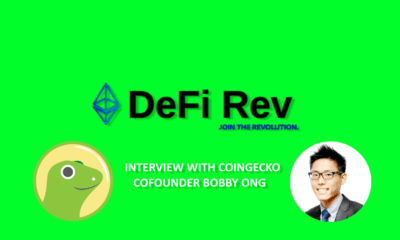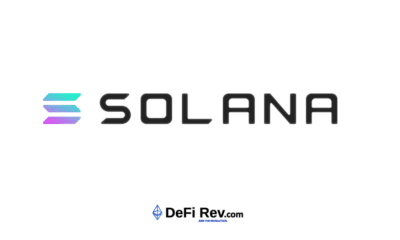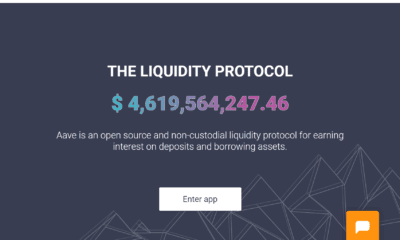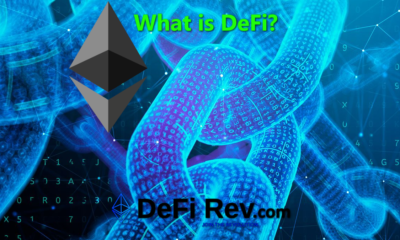news
DeFi Yield Farming: You’ve seen the term everywhere. Here’s what it is.

What is Yield Farming?
Yield Farming is essentially the act of users putting in their own funds to provide liquidity to the various DeFi protocols to “farm” the best “yield” which is in the form of native tokens for the respective protocol, thus earning additional capital.
DeFi Yield Farming — The insignia of DeFi
DeFi is an umbrella term referring to the interrelatedness of different crypto assets, Decentralized apps, smart contracts, and protocols, most of which are built on the Ethereum blockchain platform. The Decentralized finance (DeFi) ecosystem is one of the fastest-growing sectors that continues to attract new users and investments, with the current value within the DeFi ecosystem being close to touching $1.52 billion.
Whereas Bitcoin allowed individuals to make transactions without the need of an intermediary, the Ethereum blockchain added another layer of programmability with the use of smart contracts. Now, the DeFi vision integrates the concept of the decentralized financial system with the offerings of traditional products but without any central authority.
Recently DeFi Pulse announced that Compound was the largest DeFi protocol because a multitude of traders are migrating to Compound to farm COMP. Compound is now the largest application in terms of the DeFi value locked into the protocol.
Yield Farming and DeFi
Yield Farming is not a brand new concept but it surely has received a lot of attention this year.
To those who are new to the concept of DeFi yield farming and have been hearing it mentioned quite a lot lately but still do not know what it is yet, here it is again:
Yield Farming is essentially the act of users putting in their own funds to provide liquidity to the various DeFi protocols to “farm” the best “yield” which is in the form of native tokens for the respective protocol, thus earning additional capital.
The concept of Yield farming was accelerated by Compound and the distribution of their governance token — COMP. This new surge of interest led to more than $1Billion in new capital overflow in the protocol, with other lesser-known tokens like BAT seeing a jump of 20,000% in demand as traders moved to farm COMP.
Breaking Down what Yield Farming is
Yield: Returns or earnings generated and realized on a particular investment over a specific period of time, expressed in a percentage.
Farming in the case of yield farming is more like searching, harvesting, and cultivating.
Ok so let’s take a look at yield farming.
Numerous DEXs (decentralized exchanges)and protocols are always looking for liquidity providers, to ensure a functioning and flourishing enterprise.
If you lend out your digital assets and provide liquidity to one of these DEXs, in addition to what you gain on the amount you provide in terms of liquidity, you are rewarded with tokens. This is the yield you have earned, in the form of tokens, thus acquiring additional capital.
The farming part of the term refers to picking and choosing the best rates from the various protocols, and harvesting the yield based on your work.
This year an increasing focus has been on yield farming activities which are already a part of the DeFi ecosystem with projects like Compound, Synthetix, and Balancer.

COMP Yield Farming
Compound’s reward system has attracted the likes of many traders. Compound for the next 4 years will be rewarding a balanced allocation of its COMP token out of which 2880 are distributed daily. The attractiveness of the reward system has caught the eye of traders who have moved their assets into Compound to start Yield Farming COMP distributions. Other supportive projects like InstaDApp are helping COMP farming with its widget called ‘Maximize $COMP mining’ to enable users to get into this with just a click.

sUSD Yield Farming
Synthetix is a decentralized synthetic asset issuance protocol that is collateralized by the Synthetix Network token (SNX). Built on the Ethereum platform, the SNX tokens allow for the issuing of synthetic assets. In March, Synthetix initiated an incentives program for liquidity providers of sUSD which is the native stable coin of Synthetix. The campaign with a test period of 4-weeks, launched through the Curve and iearn exchange protocols, yearns to distribute 32,000 SNX tokens on a pro-rata basis to providers who stake their Curve LP tokens. This was an attractive prospect for yield farmers because you are earning interest on your stationary digital assets and liquid assets which can be sold off immediately.

BAL Yield Farming
Balancer, an automated market maker is a scalable protocol that allows its users to generate liquidity pools made of ERC-20 tokens. Balancer, in a bid to become fully decentralized, has launched its own liquidity campaign. BAL is the governance token of Balancer with 65 million sets aside for every 100 million BAL minting for the liquidity providers. At present 145,000 BAL are being distributed to liquidity providers every week attracting traders to park their funds in Balancer pools so that they can yield farm the BAL rewards.
Behind all this, Synthetix and Ren have created another Balancer pool for SNX and REN in which the liquidity rewards are distributed in the form of wrapped SNX and REN. The Balancer pool also will earn BAL tokens which would be redirected to the Curve BTC liquidity stakeholders. The Curve Liquidity provider tokens CRV could also be earned through the main BTC pool which also will be going back to liquidity providers. But both BAL and CRV are not on the open market yet and once they are available, they will be distributed on a pro-rata basis. Every week providers will get wrapped SNX & REN, BAL & CRV in tandem to their Curve BTC liquidity contributions.
Yield Farming 2020 and Onwards
Yield Farming has just started but the amount of opportunities it presents to traders to earn interest on their capital is never-ending. Its popularity is all set to skyrocket in a few months to come.
Yield Farming makes a lot of sense to users in the fact that:
1. Most all digital assets and tokens are kept on exchanges doing nothing when they could be earning interest.
2. The respective decentralized exchanges (DEXs) have spreads that are competitive and offer higher lending rates than centralized exchanges.
Yield farming is an attractive and exciting new development for both lenders and borrowers, and will definitely be getting more attention (a lot more) this year.
news
David Bailey’s Nakamoto creates Bitcoin Treasury with KindlyMD
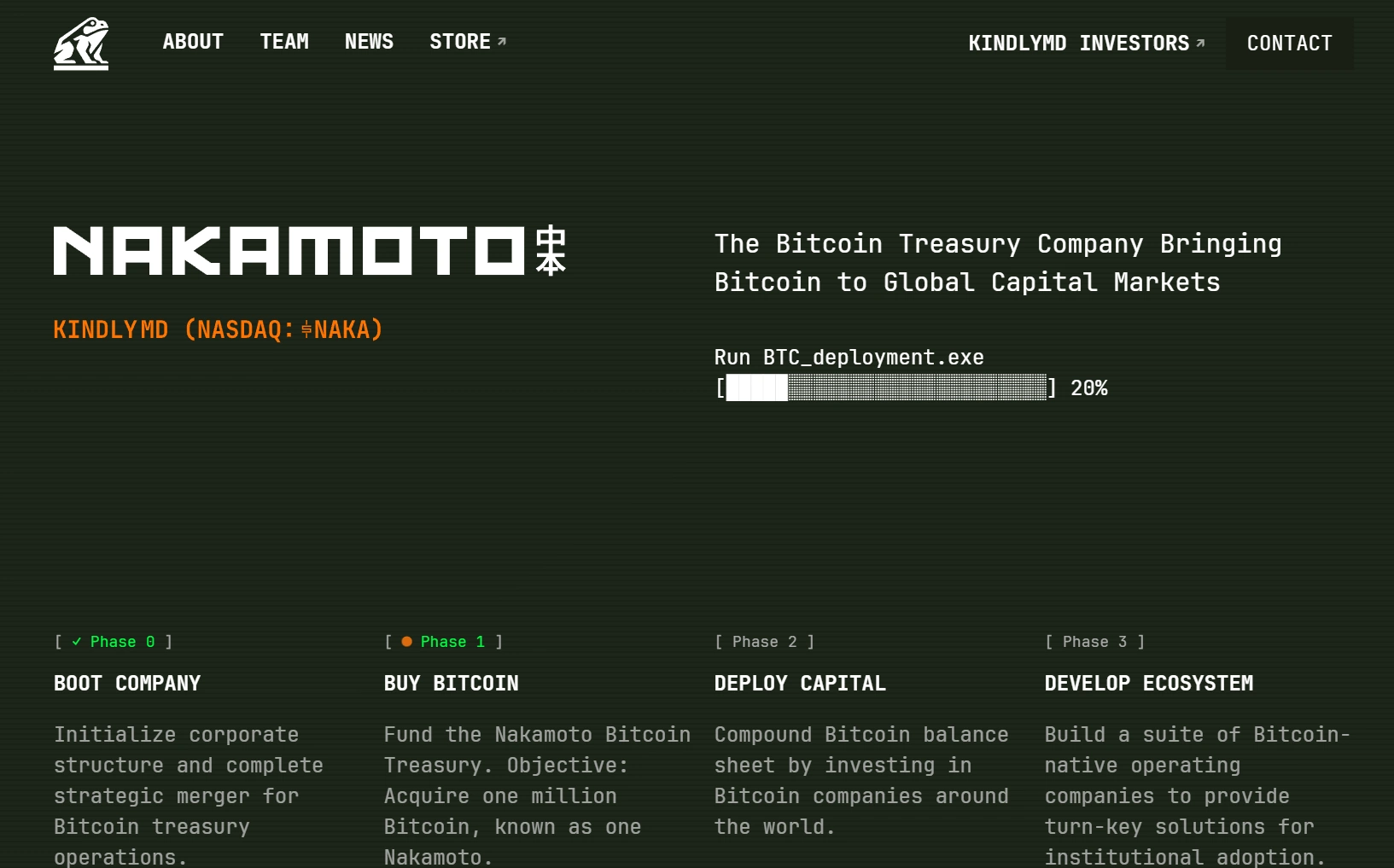
David Bailey’s Bitcoin Treasury comes to life
On August 14, 2025, KindlyMD, Inc. (NASDAQ: NAKA) finalized its merger with Nakamoto Holdings Inc., a Bitcoin-native holding company, marking a bold step toward establishing a publicly traded Bitcoin treasury vehicle. The combined entity, retaining the KindlyMD name, will trade on the Nasdaq Capital Market under the ticker “NAKA,” with Nakamoto operating as a wholly-owned subsidiary focused on Bitcoin financial services. The merger, backed by $540 million in private placement (PIPE) financing and an anticipated $200 million convertible note offering, aims to fund significant Bitcoin acquisitions and drive global adoption.
David Bailey, Nakamoto’s founder and the combined company’s CEO, envisions a future where Bitcoin anchors global capital markets. “Since my journey in Bitcoin began 13 years ago, I’ve believed it will become the most valuable asset in history,” Bailey stated. The company’s ambitious goal is to acquire one million Bitcoin, leveraging innovative financial strategies to integrate the cryptocurrency into corporate and government treasuries.Bailey revealed his plan in a post on X (formerly Twitter) on Monday, writing:
$762M Allocation to Acquire 6,400 BTC
The $762.5 million allocation, rounded up in Bailey’s statement, will be used to acquire roughly 6,400 BTC at current market prices of about $118,892 per coin. The purchase will be executed using a Volume Weighted Average Price (VWAP) strategy to minimize slippage and avoid market disruption, rather than a straight market buy.
Building a $1B Bitcoin Treasury
This move is part of Bailey’s broader $1 billion Bitcoin accumulation goal, allowing Nakamoto to join the ranks of major corporate holders like MicroStrategy and Metaplanet. Following its merger with Nasdaq-listed KindlyMD earlier this year, Nakamoto has gained access to significant capital resources, having previously secured $710 million to fuel its Bitcoin treasury expansion.
Expanding Influence in the Bitcoin Space
Bailey, who also co-founded Bitcoin Magazine’s parent company BTC Inc., has described his vision as building a “Bitcoin juggernaut” that will become one of the largest holders in the world. He also took to X recently to signal his plans to raise up to $200 million for a political action committee to advance Bitcoin’s interests in the United States.
Corporate Bitcoin Holdings Continue to Rise
Nakamoto’s purchase comes amid a surge in corporate Bitcoin acquisitions, with over 1.24 million BTC now held by public and private companies worldwide, showing Bitcoin’s growing presence in institutional portfolios.
news
Coinbase DEX launches for the first time ever
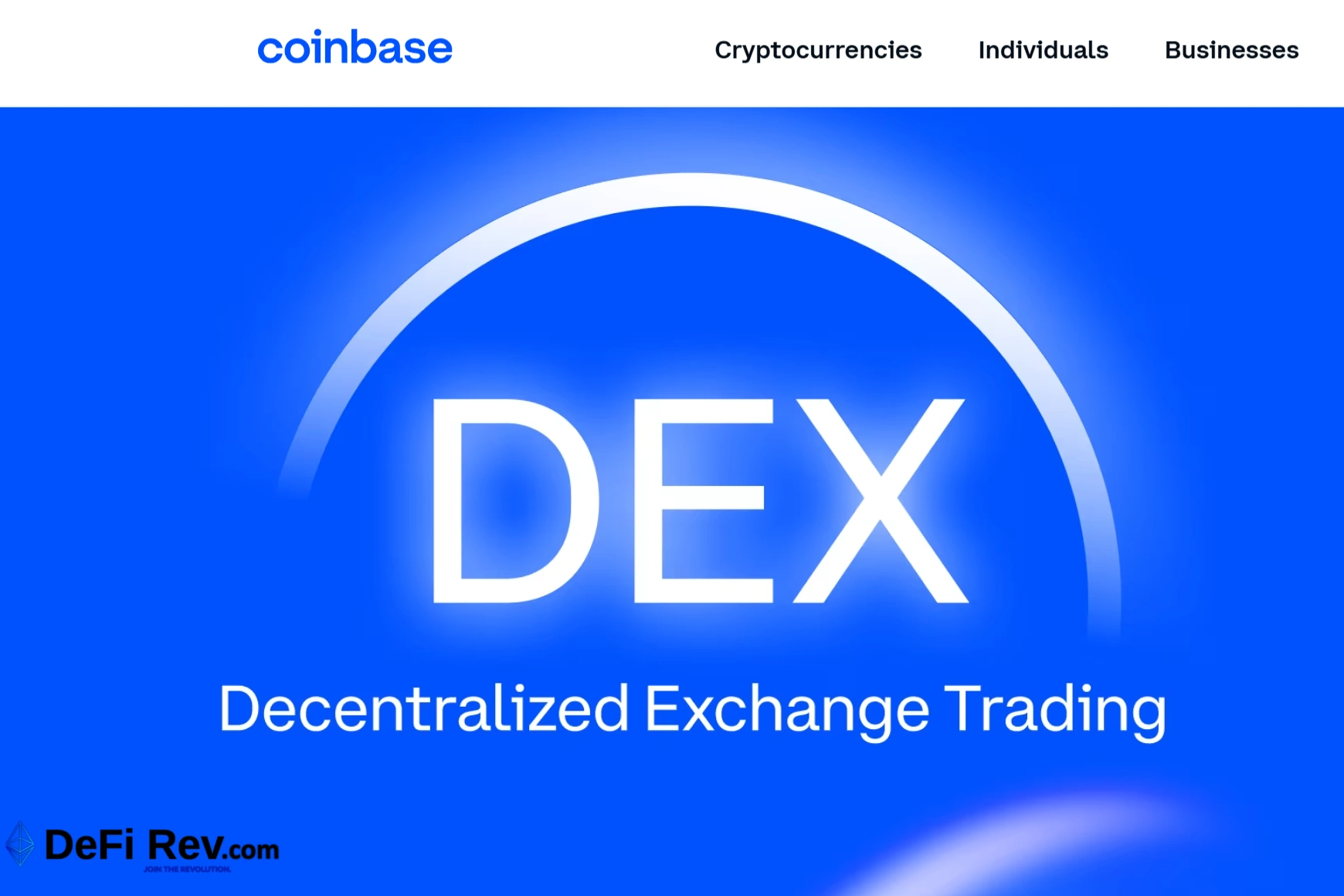
Coinbase DEX has rolled out decentralized exchange (DEX) trading directly inside its app, giving users access to millions of onchain assets without leaving the platform. The launch is live for U.S. users outside New York State and runs on Coinbase’s Ethereum Layer 2 network, Base.
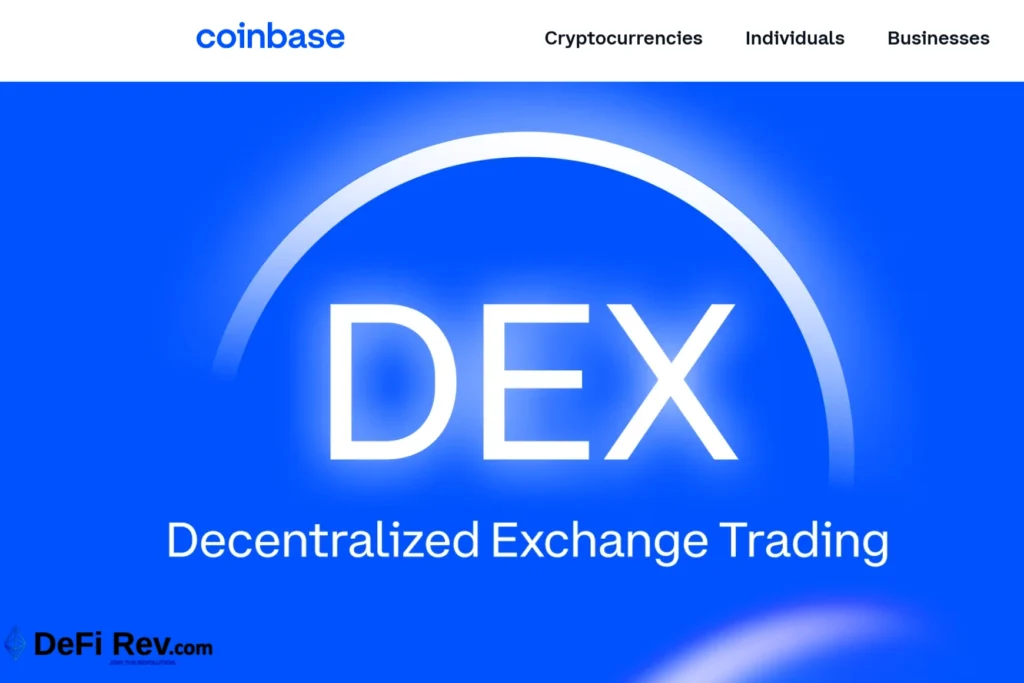
The feature introduces an integrated self-custody wallet, letting traders buy, sell, and manage tokens from the same interface they already use. Moreover, Coinbase is covering all network fees at launch, removing one of the main barriers to decentralized trading.
Faster Access to Onchain Markets
With the new Coinbase DEX integration, users can trade tokens within moments of their creation on Base. The initial rollout includes Base-native assets from projects like Virtuals AI Agents, Reserve Protocol DTFs, SoSo Value Indices, Auki Labs, and Super Champs. Support for new assets will be added in batches to maintain stable performance.
Trades are routed through Coinbase DEX aggregators that scan platforms like Aerodrome and Uniswap to secure the best available prices. Market data and risk insights are pulled directly from onchain sources, with Coinbase blocking access to tokens flagged as malicious by third-party security partners.
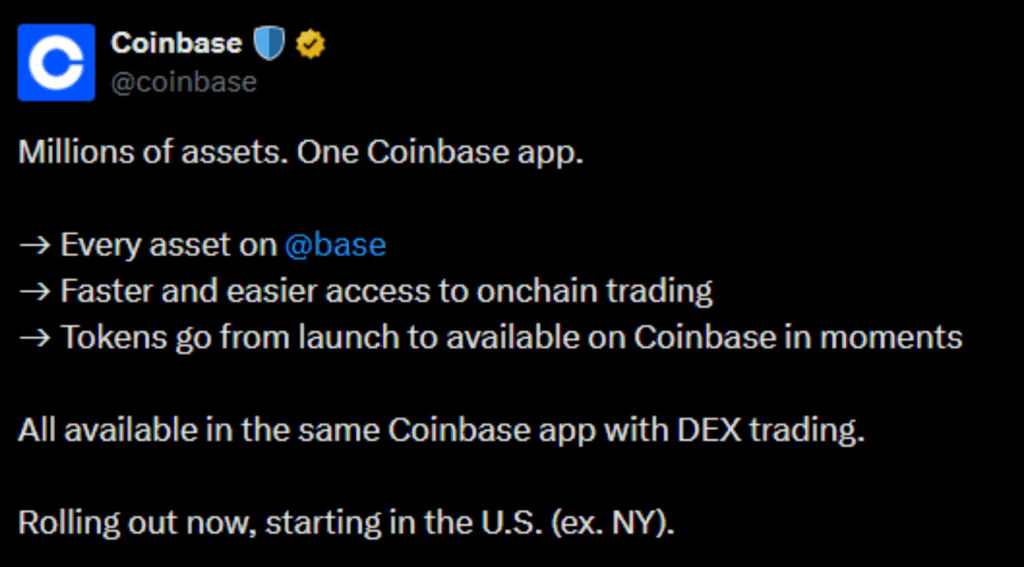
“A new era of access, going from just 300 assets yesterday to millions before long.” -Coinbase
Expansion Beyond Base
Coinbase plans to expand DEX trading to more networks, starting with Solana, and eventually to more countries. This move combines centralized convenience with decentralized freedom, offering portfolio management, fiat integration, and instant access to emerging tokens.
The company is positioning the update as part of its “everything exchange” vision, aiming to merge traditional listings with rapid onchain access. For traders and builders, this could mean faster entry to markets and a larger audience from day one.
news
Circle to Launch ARC Layer 1

USDC issuer Circle has announced plans to launch its own open Layer-1 blockchain, Arc, later this year. The network is designed specifically for stablecoin payments, foreign exchange, and capital markets, a move the company calls “the next era of stablecoin-native applications.” The announcement was made on August 12 through Circle’s official blog and X post:
Arc will be EVM-compatible and use USDC as its native gas token. This allows users to pay predictable, dollar-denominated transaction fees without holding volatile crypto assets. Other features include a built-in FX engine, deterministic sub-second settlement finality, and opt-in privacy controls.
Circle says Arc will be fully integrated across its platform and remain interoperable with the 24 blockchains already supporting USDC. The blockchain will run on Malachite, a high-performance consensus engine acquired from Informal Systems, and its core software will be released under an open-source license.
Based on their announcement, use cases for Arc range from cross-border payments and stablecoin FX markets to tokenized assets and on-chain credit systems. Circle aims to give developers and institutions a unified foundation to build stablecoin-powered applications at scale.
Arc will enter private testnet in the coming weeks, with a public testnet expected this fall and mainnet beta in 2026. As Circle put it, Arc is intended to be “the home for all forms of digital money and tokenized value,” bridging enterprise needs with the openness of public blockchain infrastructure.
-

 news2 years ago
news2 years agoPayPal Crypto Bound! PayPal is betting on bitcoin and DeFi in a BIG way.
-

 trading2 years ago
trading2 years agoBittensor booms as Chip Mania hits Stock Market: The AI Race and the Potential of TAO
-

 trading2 years ago
trading2 years agoInjective Protocol, the new Binance IEO, packs a punch
-

 trading2 years ago
trading2 years agoUniSwap Heating up BIG TIME! Is this the end of IEOs? New DeFi Projects fundraising on Uniswap.
-

 interviews2 years ago
interviews2 years agoBobby Ong CoinGecko CEO: Interview with the Trailblazing Entrepreneur
-

 trading5 years ago
trading5 years agoWhat is Solana? How SOL is aiming to solve scaling issues.
-

 trading2 years ago
trading2 years agoAAVE CRYPTO ASSET SOARING
-

 news2 years ago
news2 years agoDecentralized Finance explained. What is DeFi?

